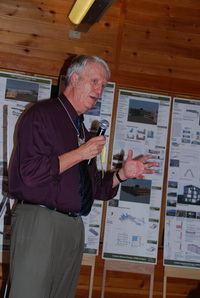 |
| |
Carbon Neutral Case Studies |
Overview: |
The Generation and Selection of Case Studies
|
Of Case Studies, Building Types and Climate Zones:
A series of real building case studies was developed as a means to begin to dissect existing strategies to achieve a state of carbon neutrality in building, in order to contribute to defining a protocol or more standardized method of design. As the funding for this project was given equally between the AIA and a private donor, whose interests lie in the area of affordable housing, the case studies were divided into two regions: commercial/institutional projects, and affordable housing. An attempt was made to distribute these as evenly as possible throughout the range of climate zones of the United States.
Of the initial list, 3 each in the commercial/institutional and affordable housing category, have been developed in detail (noted in the menu to the left with a *). Where the information supplied to the project was limited, the case studies are included, but with less detail in their development and explanation. They have been retained, as they do provide some valuable lessons and assist in providing a more broad picture of the current state of carbon neutral design.

Key to Projects
Commercial / Instutional
A. Aldo Leopold Legacy Center
B. Global Ecology Research Center
C. Sidwell Friends Middle School
D. IDEAS
E. EpiCenter Artists for Humanity
Residential
A. Wild Sage Co-Housing
B. EcoMOD 3
C. Denny Park Apartments
D. EcoMOD 1
E. Lopez Island Community Housing
Each case study was developed through active participation (donation of materials and information) of the Design Architect, and student teams at the School of Architecture of the University of Wisconsin-Milwaukee, under the direction of James Wasley, Principal Investigator of the Carbon Neutral Design Project. The student teams modeled the buildings using Revit software, and applied a Carbon Neutral Design Protocol software to each project, to determine its performance. The protocol was designed by Professor Michael D. Utzinger, of the University of Wisconsin-Milwaukee. Professor Utzinger was a central figure in the carbon neutral design aspects of the Aldo Leopold Legacy Center, the first Carbon Neutral building to be constructed in the United States.
The Carbon Neutral Design Summit - Milwaukee - November 2008
A Summit was held at the University of Wisconsin-Milwaukee in November 2008 where members of the firms that designed the case study buildings met with SBSE Professors involved in the Carbon Neutral Studio Project. The participants reviewed the case studies to begin to discern consistencies in the procedures and emerging practices for Carbon Neutral Design. Each of the case studies prepared by the student teams was further extended and refined to include a set of common topics - 'areas of investigation'. Not all of the case studies were able to be developed to the same degree of detail as a function of the availability of general information and post occupancy data.

Donald Watson facilitates the discussions at the Summit
Areas of Investigation
The more detailed case studies have identified the following key areas of contribution to designing to a state of carbon neutrality. Each detailed case study provides project response to the following 13 areas of investigation.
1. Case Study Metrics
2. Climate Analysis
3. Site Analysis / Site Design
4. Massing, Building Form and Orientation
5. Envelope Design - Solar Shading, Aperture Distribution, Thermal Concerns
6. Illumination - Daylighting and Artificial Lighting
7. Fresh Air - Natural and Mechanical Ventilation Strategies
8. Heating - Passive Solar and Mechanical Strategies
9. Cooling - Passive and Mechanical Strategies
10. Renewable Energy
11. Embodied Energy
12. Water and Waste
13. Integration Strategies
and
14. Drawings and Images are provided in a slideshow mode
Limits of Accuracy
Where all efforts have been made to ensure reasonable accuracy in the development of the drawings, diagrams and mathematical based analysis of these projects, the Carbon Neutral Design Project team does not warrant the information. A large portion of the research work has been carried out by student teams. The case studies are intended only to provide instructional reference, to assist others in developing carbon neutral design methods, and are not to be duplicated. The environmental suitability and successes of each project are limited to a specific climate zone, program and client based parameters.
The case studies are intended to be used to assist others in both understanding and further developing more detailed strategies to achieve carbon neutrality in their own design projects.
|

